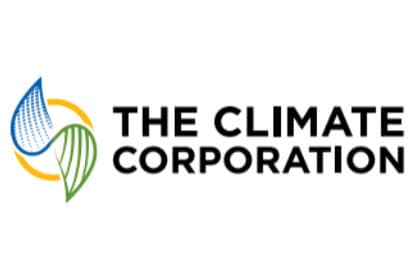 The Climate Corporation
The Climate Corporation
OpenText supports highly sustainable and innovative farming with seamless integration and analysis for data-driven decision-making.

Products and services

Outcomes
- Fully data-driven decision-making with 100% automated processes
- Minimal maintenance in a highly available redundant cloud deployment
- Sophisticated use of machine learning and geospatial capabilities
- Dashboards provide insight and guide product innovation
Challenge
Optimize resources and maximize yield with a database that performs at scale with sophisticated queries on large volumes of data.
In a few short decades, the world’s population is on pace to grow fifty percent.¹ For farmers, that rapid growth translates to an urgent need to find more efficient, sustainable ways to grow substantially more food. Now more than ever, farmers need access to tools that support the decisions they make every day to maximize their return on every acre. It is clear to The Climate Corporation that the next breakthrough will not be through genetics or equipment, but through data analytics, as explained by Dan McCaffrey, VP of Data and Analytics at The Climate Corporation: “Data drives our ability to achieve value for our farmers. Research shows that outside of climate and weather, two-thirds of variables in the food growing cycle are controllable factors, such as plant population, soil preparation, or previous crops. When we take this data and combine it with satellite imagery and weather data, we can then apply data analytics and bring it to life through visualization, so farmers can optimize resources and maximize yields. We call this agritech, and we needed a data analytics and machine learning solution to help deliver it. Vertica is a key part of that solution.”
Details
Solution
With an Amazon Web Services (AWS) cloud environment already in place, the team looked for the best data analytics solution to integrate with their existing toolset. The Climate Corporation uses Looker as a data visualization solution, Apache Spark to pre-process data, and Pentaho for ODBC connectivity for ETL (Extract, Transform, and Load) processes to prepare data for analysis. Vertica provides superior integration to all these and other existing tools, including Python and Jupiter Notebooks, as they expand their data analytics capabilities into machine learning and geospatial data.
McCaffrey comments: “We had previous Vertica (now part of OpenText™) experience within the team and felt it offered so much more functionality than PostgreSQL, our incumbent database. With the expected growth of our offering, we needed a solution that would perform at scale with sophisticated queries on large volumes of data.”
McCaffrey’s team used the Amazon Machine Image (AMI) for Vertica to create a cluster on AWS, ready for development. Farmers collect input data without the hassle of manual data entry. In a perfect Internet of Things (IoT) example, an in – cab hardware device plugs directly into their equipment – such as tractors, combines, liquid applicators, and planters – and captures machine and field data, allowing them to collect data and store it as they pass through their fields. In The Climate Corporation’s analytics ecosystem, this data is then combined with weather, geospatial, and satellite data to analyze the optimal yield scenarios for that particular farm or field. Reports are made available back to the farming clients via a SaaS application for easy consumption. The Climate Corporation also uses reports to brief leadership teams, provide insight to product teams for future product innovation, and generally optimize across the entire business with metrics.
We had previous Vertica experience within the team and felt it offered so much more functionality than PostgreSQL, our incumbent database. With the expected growth of our offering, we needed a solution that would perform at scale with sophisticated queries on large volumes of data.
Results
A wide range of data sources, combining third-party intelligence with application click stream and the field’s own data, are processed and integrated in Vertica. This results in a rich environment that provides a 360 view of the grower and their operation. Hochmuth comments: “Vertica (now part of OpenText™) enables the deep analytics that our product teams use to ensure the best product is being delivered to create the most value for the farmer. Its scalable machine learning and data visualization is critical in building a data-driven culture.”
McCaffrey concludes: “Vertica’s rock-solid performance and stability, coupled with the support received during the implementation phase, constantly reassures us we’ve made the right choice. We can see many opportunities to expand our predictive analytics and leverage Vertica’s machine learning and geospatial capabilities further.”
Vertica enables the deep analytics that our product teams use to ensure the best product is being delivered to create the most value for the farmer. Its scalable machine learning and data visualization is critical in building a data driven culture.
About The Climate Corporation

The Climate Corporation, a subsidiary of Bayer, aims to help all the world’s farmers sustainably increase their productivity with digital tools. The integrated Climate FieldView digital agriculture platform provides farmers with a comprehensive, connected suite of digital tools. Bringing together seamless field data collection, advanced agronomic modeling, and local weather monitoring into simple mobile and web software solutions, the Climate FieldView platform gives farmers a deeper understanding of their fields so they can make more informed operating decisions to optimize yields, maximize efficiency, and reduce risk.